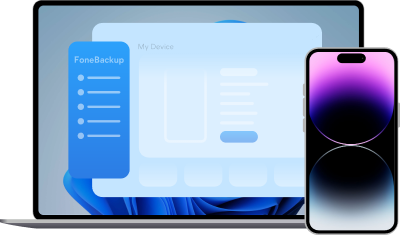iPhone Software Update Fails? 7 Effective Solutions Here
If you encounter iPhone software update fails on device and don't know how to fix it, scroll down to learn 7 solutions. And we'll show you a tip to backup your iPhone to prevent data loss.
My iPhone Software Update Failed!
I recently wanted to upgrade iOS, but every time I try I keep getting an iPhone software update fails error, How can I fix the iOS 18 software update failed error on an iPhone? And does anyone know the reason for this error?
- Question from Apple Community
Apple keeps coming up with new versions of iOS, fixing some known bugs and updating new features. But every day there are a lot of users who go through the process of iPhone software update not working, and once you try the iPhone update for the first time and are not successful, you may fall into a situation of confusion. Don't worry, this article covers all the effective workarounds that can help fix the error and upgrade your iPhone successfully.
Why Does My iPhone Software Update Keep Failing?
iPhone software update failed iS is a common problem that most users face, and thankfully, it is usually caused by some basic bugs, the main reasons are as follows:
- Network connection errors.
- Your iPhone is running out of storage space.
- The update process is not complete.
- Unable to access the Apple update server.
If you are also experiencing issues like the iOS 18 software update failed, continue browsing the article for troubleshooting.
7 Fixes to iPhone Software Update Fails
iPhone software can not be updated will cause the application can not run normally, the device to run stuttering, and other inconveniences. Don’t worry, we have sorted out the 7 most effective ways to fix software updates failing on iPhone, you can try them one by one, or according to the reason for the error directly to the corresponding repair.
Solution 1. Restart iPhone
Force restarting your device usually fixes most of the errors quickly, try it now depending on your iPhone model.
iPhone 8 or later: Press the volume+ key on the left and quickly release it. Then press the volume-up button and quickly release it. Press and hold the power button until the shutdown prompt appears, and slide to power off.
iPhone 7 and iPhone 7 Plus: Press and hold the power button and volume button at the same time for a few seconds, and slide to power off after the shutdown prompt appears.
iPhone 6s or earlier: Press and hold the power button and volume button at the same time for a few seconds, and slide to power off after the shutdown prompt appears.
Solution 2. Check Network Status
Not having a stable internet connection is often one of the main reasons why the software update failed in iPhone. You should check the Wi-Fi icon in the upper right corner, and if your network connection signal is weak, try connecting your iPhone to another Wi-Fi network. Alternatively, you can try restarting your router to refresh the connection.
Solution 3. Delete Previous Updates Firmware
If you've downloaded the iOS settings file before, there may be a case where the software update file is corrupted or incompatible. We recommend that you fix the iPhone software update verification failed error by updating the software file and restarting the update.
Step 1. Head to the Settings > General > iPhone/iPad Storage.
Step 2. Locate the update file and click on it, then tap Delete Update to remove it.
Solution 4. Reset Network Settings
If you still can't do the iPhone software update properly, it may be caused by some potential cause, such as a network setting error, which you can fix by resetting the network.
Step 1. Go to Settings > General > Reset, and select the Reset Network Settings option.
Step 2. Reselect the Wi-Fi that needs to be connected, you need to re-enter.
Solution 5. Free up Your iPhone Storage
If your device doesn't have enough free space anymore, then you won't be able to proceed with the iPhone software update. We recommend that users make sure that they have at least 5GB of available storage before doing an iOS upgrade. Now try the following steps to free up space on your iPhone.
Step 1. Navigate to Settings > General > iPhone storage.
Step 2. Remove less frequently used apps from the list, and you can also delete more pictures, songs, messages, etc. to free up iPhone space.
- Tip: Is your iPhone storage full and don't want to delete apps? Head over to learn more ways to free up storage space for your iOS device.
Solution 6. Update iPhone via iTunes
In addition to upgrading your phone, updating your device with iTunes is also effective, if you don't want to waste time on iPhone software upgrades that haven't been working, follow the next steps.
Step 1. Download and run the latest version of iTunes from your computer and make sure your iPhone is connected to your computer. Then tap the device icon.
Step 2. You need to wait for iTunes to check if there is an updatable version of iOS and then click Update.
Solution 7. Download the Firmware Manually
If you fix an iPhone software update failed with iTunes, go to this method. Manually downloading the firmware will be your last option to fix the iPhone software update problems, the process will be quite lengthy and require you to follow the steps carefully.
Step 1. From your computer, go to the IPSW website.
Step 2. Select the device and model you are using.
Step 3. Please select one under the list of Signed IPSWs and download it to your computer.
Step 4. Then wait for a few minutes until iTunes finishes the software update process.
Note: This method will cause a lot of data loss on your iPhone, and you can use AOMEI FoneBackup to back up your iPhone. Read on to learn more.
Backup iPhone in Time to Prevent Data Loss
Upgrading your iPhone can run into various risks, and you can also cause a lot of files to be lost during the process of fixing a failed iPhone software update. To ensure that your iPhone's important data is always safe, you need to backup your iPhone in case of data loss or corruption.
If you want to achieve efficient iPhone backup, you just need to choose AOMEI FoneBackup, a free iOS backup tool. Unlike iCloud and iTunes, it supports selective backup and data restoration, easily providing full protection for your device.
-
Users can make a full iPhone backup or selective backup as needed to back up your most important data.
-
It allows you to preview and select the data you really need before backup and restore.
-
It supports backing up data to multiple destinations such as PCs, external drive hard drives, USB, etc., saving storage device space.
-
During the process of restoring the backup, the tool will not delete any existing data on your device.
AOMEI FoneBackup is easy to operate with a simple interface. You can back up the files you need with just a few clicks, download the tool now, connect your iPhone to your computer, and proceed to the next steps.
Step 1. Launch AOMEI FoneBackup on your computer and click Phone Backup > Selective Backup > Get Started.
Step 2. In the next interface, you can see multiple app icons, and select the items you need to back up. Then click OK.
Step 3. Choose the right Storage Path and tap Start Backup to back up your iPhone data.
Step 4. You can then select Restore in the My Backups interface to restore the backup to any iOS device.
FAQs About “iPhone Software Update Fails”
Here are the answers to some frequently asked questions about “iPhone software update fails”:
Q1: Why does my iPhone keep restarting during software updates?
An iPhone rebooting during an update can be caused by a number of factors, such as a low battery, software conflict, or hardware issue. Make sure your device is fully charged, then try the update again. If the problem persists, ask Apple Support for assistance.
Q2: Can I downgrade my iPhone software if the update fails?
In some cases, your iPhone software may be downgraded if an update fails, but this depends on factors such as Apple's signing window and the availability of older firmware versions. Please note that downgrading may not always be possible or recommended and may result in data loss or other complications.
Q3: If an iPhone software update takes too long, is it safe to interrupt it?
Interrupting an iPhone software update can lead to problems like software corruption or data loss. It's best to let the update process finish, even if it takes longer than expected. Before starting an update, make sure your device is plugged in and has a fully charged battery.
In the End
This post provides 7 ways to fix the iPhone software update fails effectively, if you also encounter this iOS upgrade error prompt, please fix it step by step. It is worth noting that you are better off backing up your iPhone in advance using AOMEI FoneBackup, in case the data is lost or damaged during the whole process. This tool provides you with the most comprehensive iOS backup service to escort your data.

